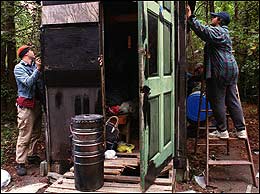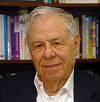The Atlanta Journal-Constitution: 10/16/02 ]
The shelter people
In hidden corners of Atlanta and environs, huts for the homeless just seem to spring up. Call it . . . stealth housing.
By BO EMERSON
Atlanta Journal-Constitution Staff Writer
| ||||||
Once at the site, Hess, 32, and a half-dozen colleagues went to work, laying a simple concrete block foundation and raising modular walls. These builders, most of them computer geeks, are not skilled with the Skilsaw, but within two hours they were putting the roof on the finished structure. A homeless man who'd been sleeping under plastic tarps was waiting to take possession.
"We do the most affordable housing in the metro area," said Jim Devlin, a 41-year-old Little Five Points resident in an Aussie hat, as he pounded nails. "We build it and give it away."
These are the Mad Housers, a band of volunteers who deal with the problem of homelessness by cutting to the chase: Every Sunday they build houses.
Very small houses.
The base model is only 6 feet wide by 8 feet long, with a ceiling that's 10 feet high at the peak. Cost to the Mad Housers: about $350. Cost to the client: zero.
For someone who's been burrowing in kudzu, sleeping in Hefty bags or hunkering under a highway bridge, 48 square feet of floor space makes a world of difference.
It's a weathertight, insulated miniature home, with roll roofing, a locking front door and a cheery wood stove piping in the corner.
One of their clients is Walt Turman, a 52-year-old auto mechanic and tree service worker, who has added a room to his hut plus space for the portable toilet. "This is the way I came up," says the former farm boy, surveying his cluttered domain a few miles away from Sunday's construction site. "I know about cooking on a wood stove 'cause my mama had to get up every morning and make breakfast on one."
Granted, what the Mad Housers do is at the margins of the law. Their huts, which they give away, are generally sited on property that they don't own. But for Mad Houser Vice President Hess, the choice between doing the right thing and doing the legal thing is a no-brainer. "We've been yelled at before and we'll probably get yelled at again."
Beth McCracken, who is studying to be a social worker at Kennesaw State University, wrote a paper on the Mad Housers for a class on grass-roots movements, and was so impressed she launched a fund-raiser to pay for a new hut. "Technically they try to fly under the radar," says McCracken, 34. "I think they're awesome. They're taking on a cause that's overwhelming -- the city can't handle it -- and they're helping out, one person at a time."
According to longtime member Frank Jeffers, 59, the original Mad Housers, who first cohered in 1987, were politically provocative. They built huts in "ostentatious places" to raise awareness of the homeless problem.
But quality control was low. The plywood was thin, the huts uninsulated, the windows too big. "They leaked heat like a sieve and they were totally unsecure," says Hess. "It was a good first pass."
Like many of their huts, that group fell apart in the mid-1990s. The Mad Housers regrouped about two years ago, focusing on shelter, not politics.
Today the Mad Housers succeed by thinking inside the box. For example, consider their unique wood stove design, created by Jeffers: It is built of four nested galvanized shop buckets, with a lid and a 2-inch-diameter vent pipe to carry smoke up through the roof. Perforations at the base control air flow. Cost: about $30. (Clients receive instruction in using the cheap stove, and its safety record is good, says volunteer Kurt Haas.)
The low-budget group, composed of activists, software writers and the formerly homeless, works the same way. The Mad Housers operate on a minimum of fuel, efficiently turning income into shelter. Their huts are exactly the length of two sheets of plywood and the width of one and a half, meaning a minimum of cuts per sheet. Classed as "emergency shelter," the huts are intended to finesse housing codes that apply to permanent dwellings.
Sometimes their overhead is so low they bump their noggins. At a recent "build" they used a plastic bottle filled with water for a level, and they were forced to flatten the hut site by digging in the dirt with pointy pieces of wood and their bare hands.
"We need a shovel," says Devlin during a Mad Houser meeting at a Midtown coffee shop. At the meeting they discuss the upcoming Sunday's construction activities and ways to capitalize on National Hunger and Homelessness Awareness Week, which starts Sunday.
They also talk about a van. Hess, a computer programmer at Weather.com, reports that insurance on a "company" van will cost $1,500, the entire Mad Houser bank account. No van, man.
Their profile is low and their donations are low too. Yet support comes from a wide range of folks (including an anonymous donor who communicates only through a Washington lawyer).
Middle school students from Atlanta and Boy Scouts from Lilburn have helped on Mad Houser projects, with funds donated by the Georgia Vietnam Veterans Alliance. A Powder Springs church joined them on a build, and this summer the Furniture Bank of Metro Atlanta donated warehouse space so they could do some of their carpentry inside.
But they've yet to be embraced by the mainstream. Folks in Habitat for Humanity (where starter houses cost $46,000) prefer not to comment on the guerrilla builders. Hess doesn't even want to approach the "big box" retailers such as Home Depot for free plywood. He figures few corporations want to claim charitable deductions to habitual trespassers.
In the meantime, the slumping economy and promises of a cold winter keep business brisk. All two dozen of their huts are full, and there's a waiting list six deep, with requests for huts in places far from downtown Atlanta. (There are potential clients camping in woods around Marietta.)
Some supporters are troubled by the group's underground tactics, but sympathetic to their goals. Phil Greeves of Lilburn says he'd prefer it if the Mad Housers got permission instead of hiding their huts, but he acknowledges that in most cases they'd be denied.
Adam, Greeves' son, built a hut two years ago to fulfill the community service requirement for his Eagle Scout badge. The project changed their opinions about the homeless. "These were not unproductive people," says the father. "They were working Monday to Friday, and on the weekends they'd come out and help with the house."
On the ethics of madhousing, Bill Bolling, founder of the Atlanta Community Food Bank, comments, "I would say you ask forgiveness instead of permission in this case. This is a small legal question vs. a big social issue."
Mad Houser Peter Richards, a teacher at Paideia School, sums up the question this way: "In America," he says, "you have two choices if you're homeless: charity or trespass."
The city hasn't prosecuted any Mad Housers in recent memory, says Sandra Walker, spokeswoman for Atlanta Mayor Shirley Franklin, though the city has asked that some structures be removed. "It's an unfortunate situation," says Walker. "It's what [the Mad Housers] feel they have to do, but certainly we have to respect the right of the property owners, and follow the laws."
The Mad Housers will always remove huts if asked by the property owner, says Haas. The group tracks ownership by checking plats, and on at least one occasion disassembled a village when the property changed hands. It will also take down a hut if a resident causes a problem for the neighborhood.
Haas says he doesn't know whether the huts pose a liability risk for landowners, but adds, "In general the sites where there is a clear property owner, the property owner is tacitly aware they [the huts] are there."
Many "hutters" stay a short while, saving enough money to get an apartment or subsidized housing, at which point they turn their huts over to the next in line. Others stay longer. "This reminds me of Boy Scouts," says Joe, a Ghanaian expatriate who has been in his rustic shelter for five years.
If constructing stealth housing is a trend, it's a quiet one. Jim Reid, a perennial candidate for public office in San Francisco, has designed a 10-by-10 house to be mass-produced for that city's homeless, but none is currently in use, perhaps because of the $12,000 price tag.
A similar movement rose and fell in Chicago, and a group in Canada called the Peterborough Collective is trying to raise interest in similar shelters. "It can snowball, even if it's not a big ball," says Richard Van Slyke, an independent videographer who has been taping a documentary about the Mad Housers for four months.
One thing that Van Slyke and others notice about the group is that it is motivated by a desire to do the right thing, even though few of the Housers seem to connect that desire with a religious affiliation.
Salma Abdulrahman, a telecommunications software programmer, says her urge to volunteer with the group doesn't grow out of her Muslim faith as much as from her basic character.
"We're all human beings, we're all people, when you come down to it," says the 24-year-old. "I'd be doing this if I were any religion. It's just part of my personality."
On a drizzly, mackerel-clouded Sunday at another hut site, Abdulrahman is demonstrating her philosophy by hauling wheelbarrows full of firewood from hut to hut, while Jeffers wields a chain saw.
This small village of huts is located on the bones of a ruined amusement park called Funtown. Turman once visited Funtown as a child, when school buses brought a pack of teenagers up from his Heard County high school. Now he lives next to the defunct merry-go-round, which is reduced to a weed-cracked concrete pad.
Here residents carry their water and heat with wood. They grow vegetables and make their own charcoal under Joe's guidance. Turman powers his portable TV with a 12-volt car battery.
"We're just trying to get society back into some kind of balance," says Jeffers, pausing for some cowboy coffee perking on a galvanized drum fire. "Some people have got so much more and other people don't have any heat."
What they provide, says Hess, is hope and dignity, along with a dry place to sleep. "Once you give people a certain amount of hope," he says, "civilization begins there."
Funtown: A Third World village in the middle of the city
This resident left before the gen-car arrived. The gen-car changed everything.
-- Bo Emerson













No comments:
Post a Comment